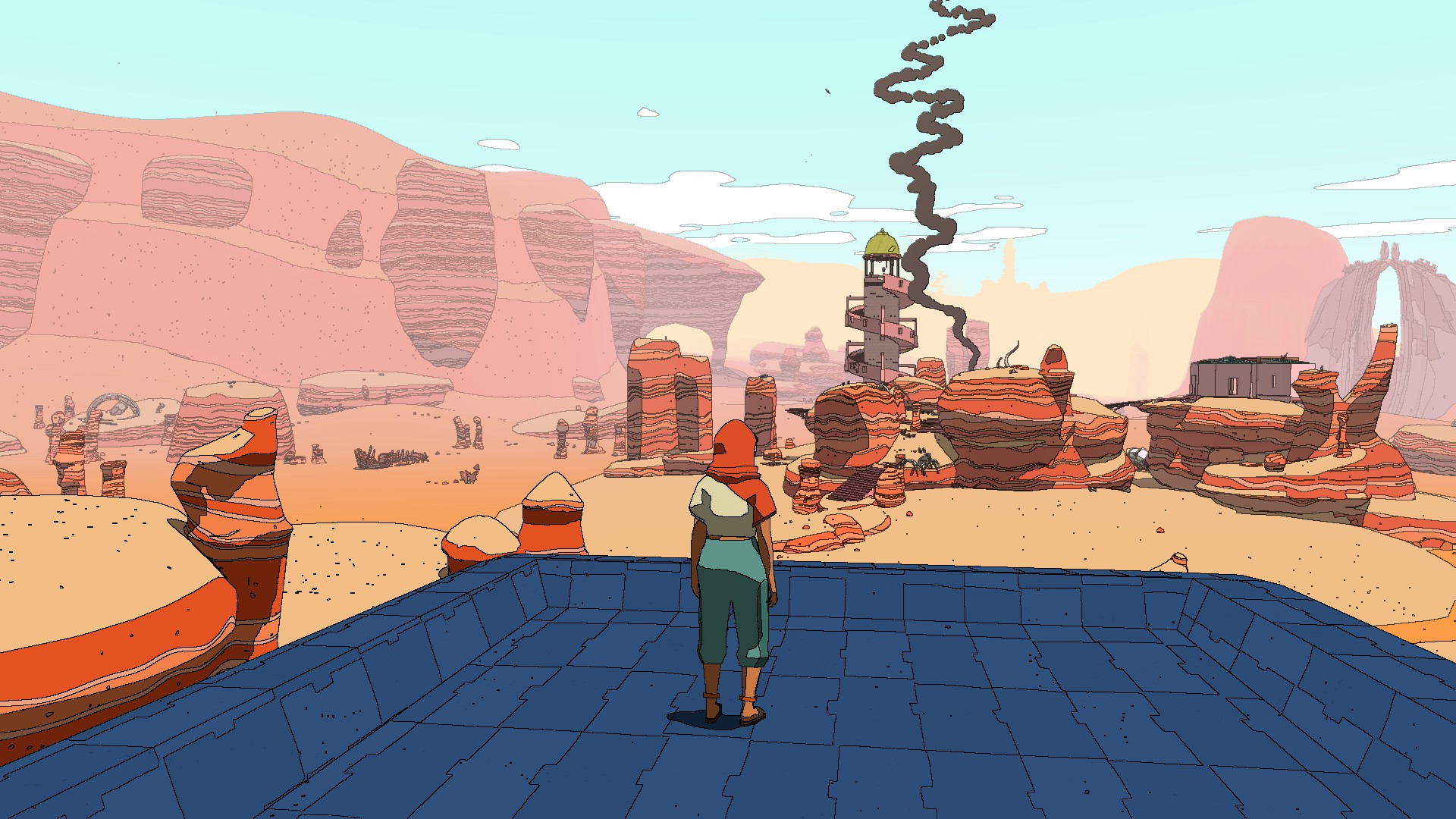
Sable, a new 3D exploration game by Shedworks, differs most noticeably from its contemporaries in its leisurely pace, and in the way its design and construction reinforces that pace. From the very start, the player and the player character both are reassured that there is no need to rush in Sable — you are meant to take your time, to explore but also inhabit the world, to consider your place in it as well as the place you'd like to occupy. The scale and sparseness of the game's world, especially in contrast to Sable's speed and even the speed of her hoverbike Simoon, can help encourage and evoke that contemplative mode.
In addition, Sable also features a simple, optional player mechanic which pushes towards this goal: a Sit button. Whenever you so choose, whether by a fire in a settlement or atop a high point in the world, you can have Sable plop down and just sit there. It's a mode the player must explicitly enter with a button press, and only certain controls will exit this state; jostling the analog stick won't cause you to bolt upright, and the animations of Sable sitting and standing are quite slow. To sit in Sable is to say "This seems a fine spot to rest — lemme just catch my breath."
I love mechanics like this in games. Anything that allows me as a player to embody the role and behavior of the character I'm inhabiting, regardless of its value in the game system or whether the game demands its use, is valuable in and of itself. In Sable I wanted to sit with the Crystal Farmers in the southwest, in part as a shocked response to their startling scale. I wanted to sit with the kids in Eccria to relax after finishing a game of hide-and-seek. I wanted to sit with the Ibexii I'd grown up with before heading off to the temple to end my Gliding — to spend just one more moment as Glider Sable.
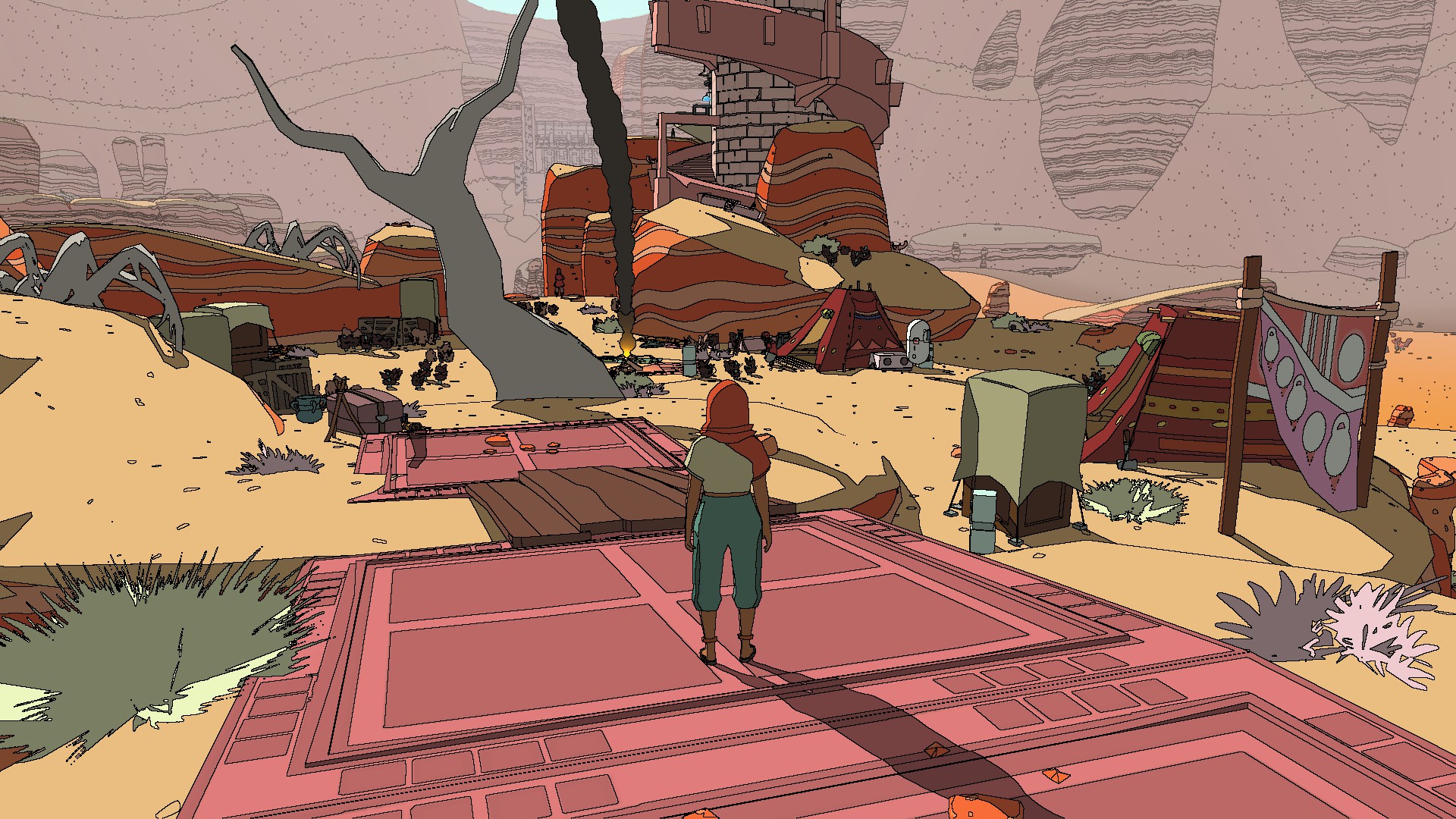
The core goal of Sable is to complete the Gliding, the ritual/pilgrimage/journey which Sable embarks upon after the more contained opening section of the game. The purpose of the Gliding is to find and ultimately choose the mask you wish to wear in the world. Amongst the cultures in the setting of Sable, masks communicate a tremendous amount of information: they are reflective of the community one associates with, the skills one has developed, the vocation one has devoted oneself to, the way one is seen or wishes to be seen. Choosing your mask — and completing the Gliding — represents the culmination of both Sable's journey as well as the game as a whole.
Sable does not feature a mandatory or near-mandatory series of quests which serve to push you through some central plot. There is no great conflict which presents itself and gets resolved by the game's conclusion. The game seems (magnanimously) ambivalent about which mask you'll acquire first, or which mask you'll choose in the end, for that matter. In fact, in order to finish Sable, you only need two things: at least one new mask, and for your clan to complete their brief pilgrimage and return to the Ewer (and it seemed to me that the latter was scripted to occur the moment you accomplish the former). The guiding hand of an overzealous game designer is absent; the game is truly as free for you as it is for Sable.
As you explore and complete quests and engage with the world and characters of Sable, you collect masks (or badges, three of which can be presented to the Mask Caster to create a single mask). Mask pieces are usually rewarded by members of a given faction when you complete tasks for them, and those tasks offer a sense of the kind of life Sable might have after her Gliding, should she choose that mask in the end. You can wear any masks you gather at any time in the game, trying them on for size and getting a sense of how that presentation works for you, but eventually you know you'll have to commit to one of them, and that choice will have consequences for Sable beyond the scope of the game. This means that the stakes at play in the game's story are personal: Sable's self-discovery — her introduction to, and transition into, the wider world.
From a design perspective, this structure evokes The Legend of Zelda: Breath of the Wild and its beautifully elegant central goal: to infiltrate Hyrule Castle and kill Ganon. In both games, the opportunity to end the game is granted to you very early on, but in Breath of the Wild the game's level design and systems are what stand between you and accomplishing your goal. Hyrule Castle is surrounded by a wide moat, and the enemies inside the castle are far more powerful than you are to start. These factors, among many other things, encourage you to explore the world, complete shrines to increase your health and stamina, and collect armor and weapons and items that will help you overcome the obstacles between you and the game's conclusion.
In Sable, the obstacles are psychological, the struggle internal. I collected every mask that's available in the game, and when the time came to choose just one of them, I spent several minutes frozen, unable to make a decision. The Gliding, as a design construction, is simple and clear enough to act as the backbone for all of your adventures in Sable, but also such a rich and engaging narrative premise that it manages to infuse every moment of Sable's journey with meaning: joy, anxiety, wonder, heartache.
I don't think I've played a better coming-of-age video game in my life.
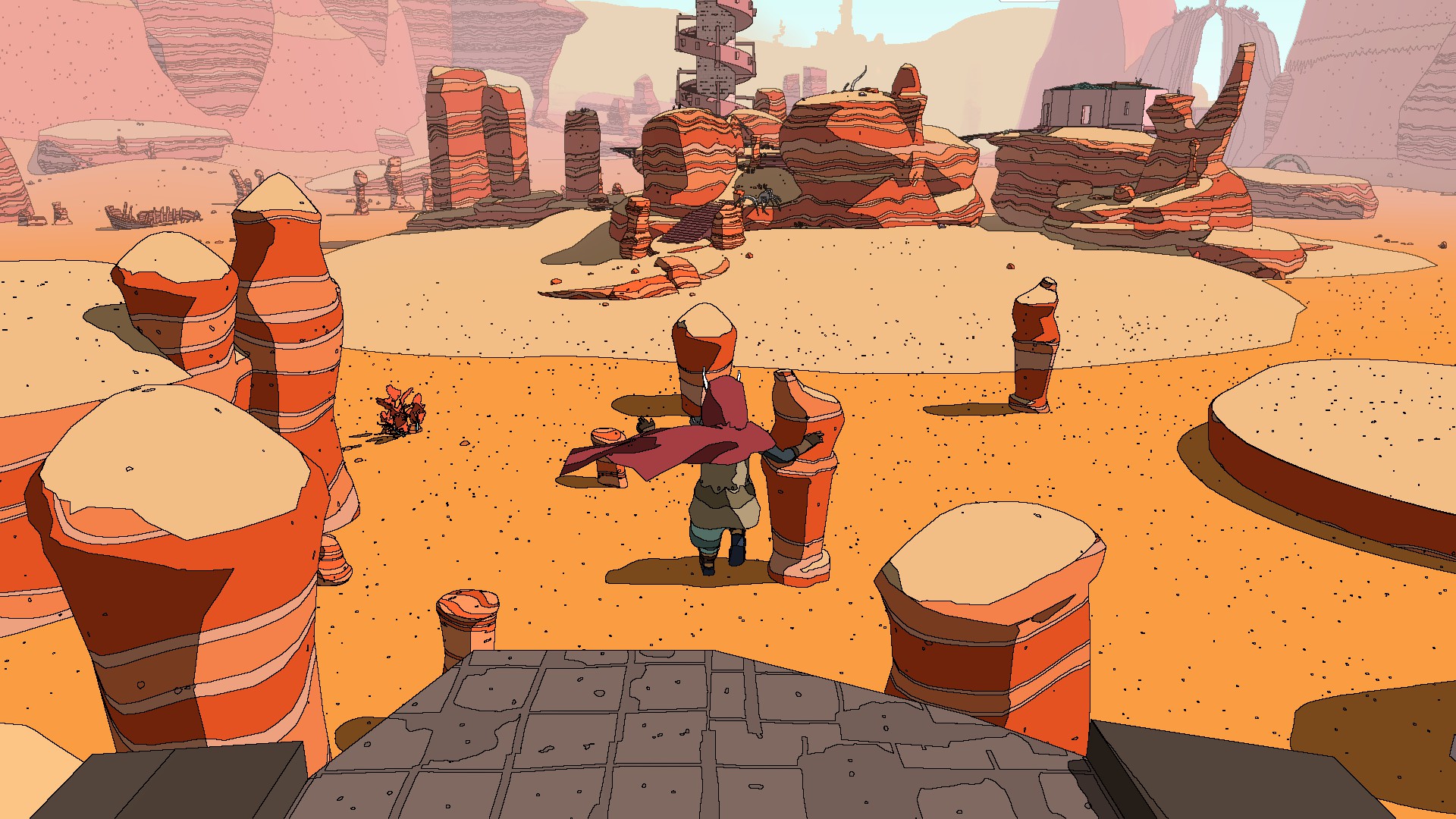
I have just one problem with the Sit mechanic in Sable: I didn't discover how to do it until I had nearly completed the game. The means by which you engage with this interaction (that is, the button you press to employ it) is never naturally surfaced to the player. It exists only in the Show Controls section of the Options menu, on a controller diagram or list of key bindings. In part, I want this piece to serve as a public service announcement: press the R key or Down on the d-pad to sit in Sable!
I understand the impulse to not explicitly tutorialize this mechanic, much as I disagree with the choice. It's not required to complete any quests, it's not a back-of-the-box feature, it doesn't make the game more "fun." But I would argue that it's an essential piece in the game's toolkit when it comes to helping the player embody Sable as a character and as a player avatar. The feeling of standing next to a campfire, for example, as opposed to sitting next to one is different in a subtle but powerful way, as is the meaning expressed by those two actions. The ability to Sit in Sable gives the player a means to take their time and reflect on Sable's journey (a journey they have shared with Sable) in a way that is reflected within the game world and its simulation. It reinforces the pace and the mood the game cultivates throughout.
. . .
There is a scene in the game, at the end of one of the longer questlines, in which Sable sits when talking to another character, and it is, perhaps, the highlight of the game for me. After asking around for and eventually finding someone named Llhor the Fabulist at the request of a member of the Atomic Priesthood, you sit fireside with the itinerant poet in a cave in the Sodic Wastes. In almost all other cases, Sable stands when speaking to another character, either looking up at a figure with something to teach her or down at someone who has more to learn than even her. Here, far from any other settlements and amidst the detritus of what seems to be another people, you sit with Llhor, level, and attempt to offer her the wisdom of a Glider.
Llhor confesses a growing dissatisfaction with her vocation, despite the stability it guarantees and the delight it still often provides. When she describes how the Priesthood lavishes her with gifts so long as she sings their praises in poetry, Sable can respond in one of two ways: "Sounds great" or "Sounds stifling." Similarly, when she asks you directly whether she should return to Eccria, you can only offer an ecstatic "Yes!" or "No!" Every available response you have to Llhor feels like it is boiled down to an impossible binary, to which she argues that things are, of course, not so simple.
I quit my job a few months back. Pretty soon afterwards I drove around the country on my own, visiting national parks and seeing friends and family. This is to say I saw some of myself and my situation in Llhor.
In the end, Llhor returned to Eccria and the Atomic Priesthood, but I never saw her again. I'm still not sure she made the right choice, or if what I had said resulted in her doing something she didn't want to do.
. . .
Before I had discovered the Sit mechanic, I'd felt its absence. A number of times in my playthrough, I would encounter a resting place, or a striking element of the landscape, and been compelled to sit with it for a moment, but found myself unable to. Those moments I listed towards the top of this piece were, for the most part, not anecdotes — they were instances of desire unfulfilled. The window of opportunity for several of them had passed, but the Crystal Farmers still stood beneath their dormant labor mechas; the Wyrm still towered over the sands of the Wash; the people of Burnt Oak Station, my first stop after the start of my Gliding, still engaged in their daily routines.
Following my discovery, I flashed back to all those places and situations in the game where I wished I could have just taken a breath and sat for a while. As I was about to close out all the quests I felt capable of completing (I did not find all of the Korok Seed-like Chum Eggs hidden throughout the game world, which you can eventually trade in for an extension to your stamina meter), I decided to take one last tour around this world, just to sit with it for a little while longer.

My late-game jaunt was made... well, not possible but easy thanks to another hidden mechanic in Sable: fast travel. If you've visited a key location in the world, it will be marked on your map, and if you then interact with that icon on the map, you will be prompted to fast travel to that location. Many open world games feature fast travel, but just like the Sit mechanic, Sable does not surface this mechanic explicitly to the player.
I discovered fast travel after a lengthy journey which started in Eccria, de facto capital of this world, and carried me from the north to the northeast to the eastern portions of the map. I can no longer recall which particular quests I was pursuing, but I remember realizing that the space to the northeast of the Ewer, the home of the Ibexii clan and the valley in which Sable begins her Gliding, was not simply a lacuna between the natural bounds of the world and hard edges of the map's frame. Through a fairly narrow path, I entered the Sodic Wastes, a desolate canyon dotted by the debris of starships and the structures of a prior culture. This is where, much later, I would find Llhor hiding in a cave, retreating from the life she'd built for herself.
From a world design perspective, the Sodic Wastes are brilliant. They wrap all the way around the Ewer's high natural rock walls, from the north edge to the west edge of the map. They feel alien, both because they look like a salt flats rather than the sandy desert dunes of much of the rest of the game, but also because the relatively rare offworld tech is here in abundance.
Adhering to my usual itinerary when finding a new area in Sable, I first found the Cartographer by their balloon, scaled a shipwreck to reach them, and purchased a map of the region. Then, from that great height, I studied the area and identified interesting landmarks with the Navigator. After adequately satisfying my curiosity, I decided to resume my intended journey; I traveled south toward the Wind Tower, which is the focus of an early quest after you embark on your Gliding and leave the Ewer.
It's a long ride from the Wind Tower to Eccria, and I was prepared to make it, but before I did I checked the game's map and, by accident, interacted with Eccria's symbol on the interface. This raised a prompt asking me whether I'd like to travel to Eccria. At this point in my journey, there was nothing left to accomplish between here and there, so I accepted the game's generous offer.
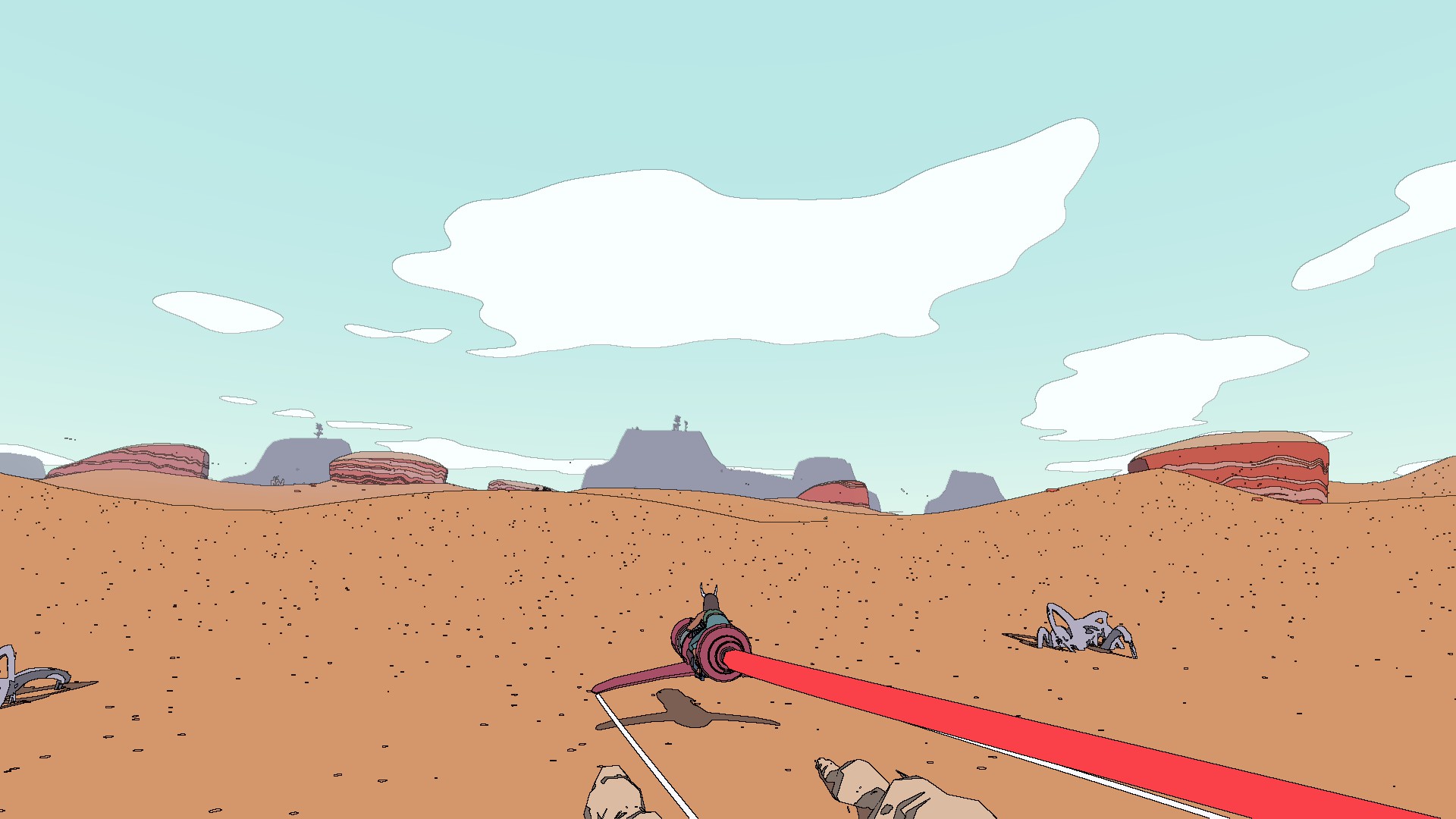
Core to the experience of travel in Sable is your hoverbike, Simoon, and how she exists as an entity within the world. When you dismount from Simoon, she stays where you've left her. If you want to continue to explore the vast world at a reasonable pace, you must reunite with her, which you can do by either walking back to her on foot, or by calling for her with a whistle, at which point she will try to approach you.
I say "try" because, in my experience, Simoon does not reliably return when summoned. If there's a difference in elevation, she'll pause in place; if the corners are too tight, she'll get stuck; if she's out of eyesight, it's hard to tell whether she's moving back towards me at all. This meant I always had to be conscious of where she was, how far I was from her, what path she might have to travel to get back to me. More often than not, I would find myself returning to Simoon rather than the other way around.
As much as it feels like a bug that Simoon has such trouble pathfinding to you when summoned, I find it appropriate that the game asks you to care for her as an entity in the game in addition to as a narrative element. One of the major factions in the world of Sable is the Machinists, a guild of tinkerers and engineers represented in each major settlement. The Machinists you meet each offer part of a philosophy about how creation differs from building; how a machine is created at the same time each of its individual — and initially separate — parts is created, and that a machine's spirit yearns to be built, to have its component parts joined together into a whole which is the machine's self. So whenever I called Simoon and she failed to answer, I saw this as her expressing her spirit, inconvenient as that might be.
Fast travel, however, changes this dynamic by bringing Simoon with you wherever you teleport. If you travel to a settlement, she'll be parked beside the other hoverbikes; if you travel to a landmark in the open desert, she'll be somewhere close by. This convenience, like the convenience of fast travel, is hard to turn down once it's been offered to you, and I cannot imagine this mechanic working any other way: the fictional conceit for fast travel is evidently that Sable rides Simoon to the chosen destination, so why would Simoon remain wherever you were when you engaged in fast travel? But what it does is tip the scales towards the use of fast travel in even more circumstances. Fast traveling to a quest giver after having abandoned Simoon to explore some massive landmark can often be the equivalent of killing two birds with one stone.
. . .
Fast travel is not an uncommon mechanic in games, particularly not since the rise and mass popularity of open world games. A great number of AAA games which would have previously been a linear series of discrete levels are now set in open worlds, with missions beginning at one point in the world and utilizing a subset of that space as the "level" for that mission.
There are a great number of factors which influenced this trend in the games industry broadly, but for the purposes of this piece, I'm going to ignore them and just state that I believe this trend has had a deleterious impact on games and game development, and I wish it weren't so prevalent. I'm not against open worlds — I think games like Sable and Breath of the Wild, as I've discussed above, are brilliant and fully justify being set in huge worlds. But by employing this design paradigm, they carry along some of the same assumptions made by lesser titles.
Fast travel, necessarily, collapses the virtual space of a video game. If a game is constructed as one massive, contiguous space, and if traveling between two arbitrary points within that world takes time and any amount of effort, then fast travel nullifies that distance, and subsequently the time and effort of travel. In most games, including Sable, you're not able to fast travel to a particular point until you've already traveled there once before, so that time and effort is only ever demanded of you once. After that, any failure to use fast travel to optimize your time spent moving between points of interest in an open world game is a willing refusal to save one's own time.

In accordance with my distaste for open world games, I often find myself responding negatively to fast travel systems, but I understand the reasons they've proliferated amongst games of this sort: games are long, people are busy, and in many games, repeat travel does not produce any meaningfully novel or unique experiences. The same is true of Sable, actually — you could travel the same path between, say, Eccria and the Wind Tower a dozen times and never encounter something dynamic or emergent. The world, in terms of game elements, is static. As a means of allowing players to save their own time, and as a way of not testing the player's patience unnecessarily, fast travel is a welcome addition to many games.
Despite all this, however, I still chafe against fast travel for two reasons. The first is that I find travel in games to be a very meaningful action, even in the absence of dynamic world elements. Like being able to simply take a seat, having to consider the terrain and your route through it and the time it will take to reach your destination helps me feel like I'm experiencing the game through the lens of a particular character within it. That journey from Eccria through the Sodic Wastes and back felt characterful, plausible, and knowing how far the Wind Tower was from Eccria made it all the more weighty in my mind. By becoming familiar with the world as an inhabitant in it would, I felt more like Sable. Whenever I fast traveled somewhere, I felt less like her.
The second reason is that I am exactly the type of motherfucker to use (and abuse) fast travel. It's often said that players will optimize the fun out of a game if you let them, and upon deep self-reflection I find that I am, in fact, players. Obviously I used fast travel as soon as I discovered it, but I also continued to use it, extensively, in order to clean out the quest log and the game's achievement list. In the end, I willingly turned Sable's world from a full space into a series of points, all equidistant from each other and from my own position. I turned journeys into errands, and I wish I hadn't.
. . .
Every game in which the player controls an avatar (as opposed to being disembodied in one way or another: think The Sims or Age of Empires) necessarily features a relationship between the player and their avatar, and one element of that relationship is the gap — the emotional and experiential distance — between the two. For some games, Sable among them, closing this gap as much as possible is vital to accomplishing the artistic goals of the developers.
It's here where a similarity between Sable's fast travel system and the Sit mechanic emerges, beyond the simple fact that they are both "hidden" within the game's design: each of them exerts some influence on that experiential gap between Sable and the player themselves — the act of fast travel widens that gap, where the Sit mechanic bridges it.
By hiding a feature or affordance, you can downplay its influence on the way the player interacts with the design as a whole. Hiding fast travel, then, is a decision I agree with because I believe limiting the impact of that action on the player's experience — and that experiential gap — is quite important. In the case of the Sit mechanic, though, the perceived inability to perform this action actually widened the gap for me — I felt very sharply that Sable and I were not perfectly aligned in those moments where I most desired to sit and was unable.
More than anything it's the clash between these two hidden mechanics that I find fascinating. Fast travel is all about expediting the play of a video game, refusing to spend more time than is "necessary" in that world; sitting is a deliberate prolonging of play, a soft rejection of the idea that you could empirically classify any part of a game experience as necessary or unnecessary.
Faced with the simultaneous presence of these two mechanics, I became a pawn in the struggle between the seemingly opposing philosophies they represented. As I've detailed above, I engaged in both mechanics when I felt it appropriate, and sometimes more than I wish I had. Are the minutes I shaved off my total playtime by fast traveling somehow more valuable than those that I added back on by just... sitting for a second? Or is it possible that there is a difference between a waste of time which is meaningless and one which is meaningful?
By engaging with the medium of video games, I think we tacitly agree that there is a distinction, and that we often hope that whatever game we've chosen to play lands squarely on one side of that coin. Luckily, some games give us the power to find the right balance, but often that takes the form of ways to excise the meaningless moments, rather than to introduce meaningful ones. I'm grateful that Sable offers us the latter.
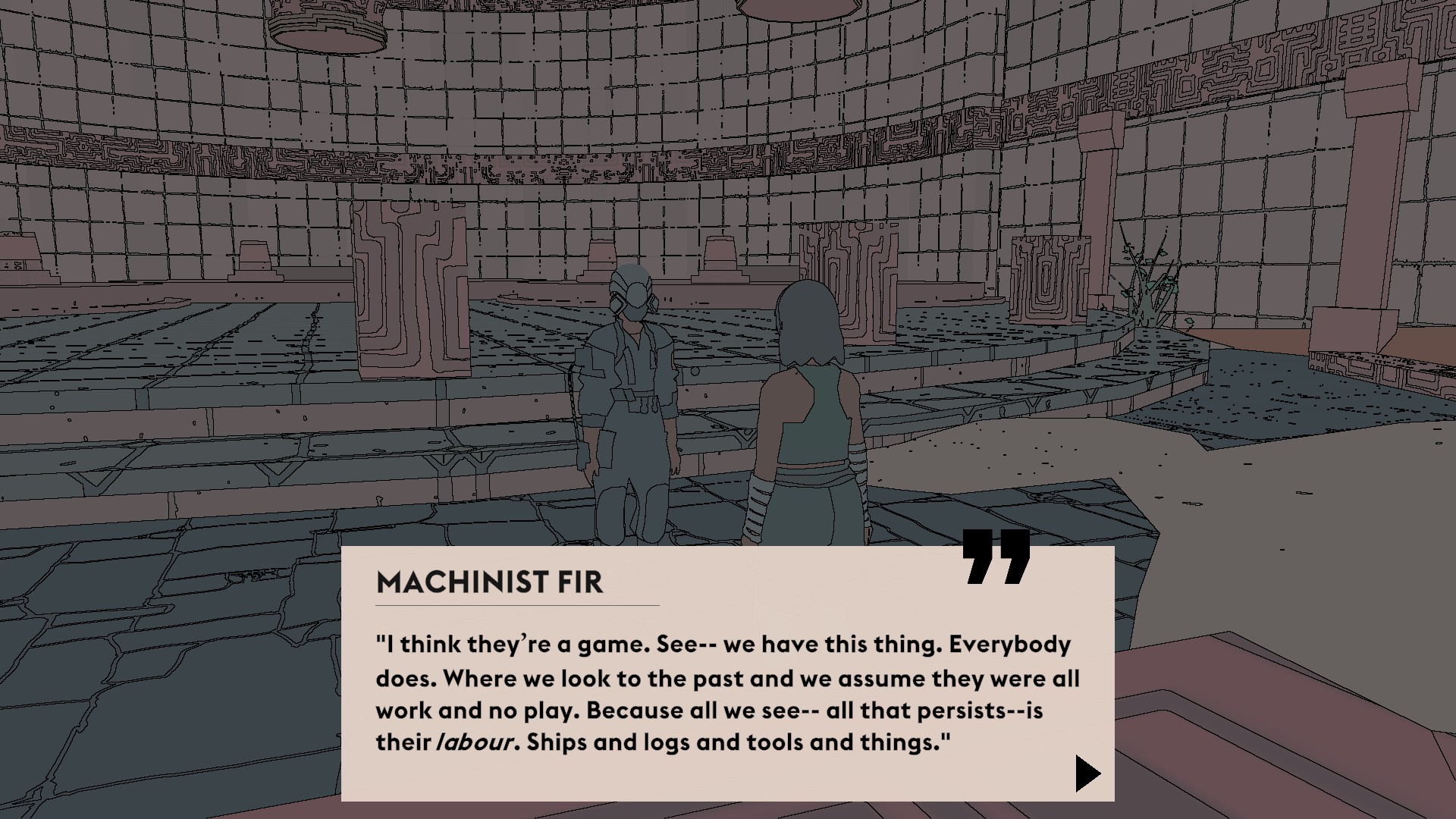
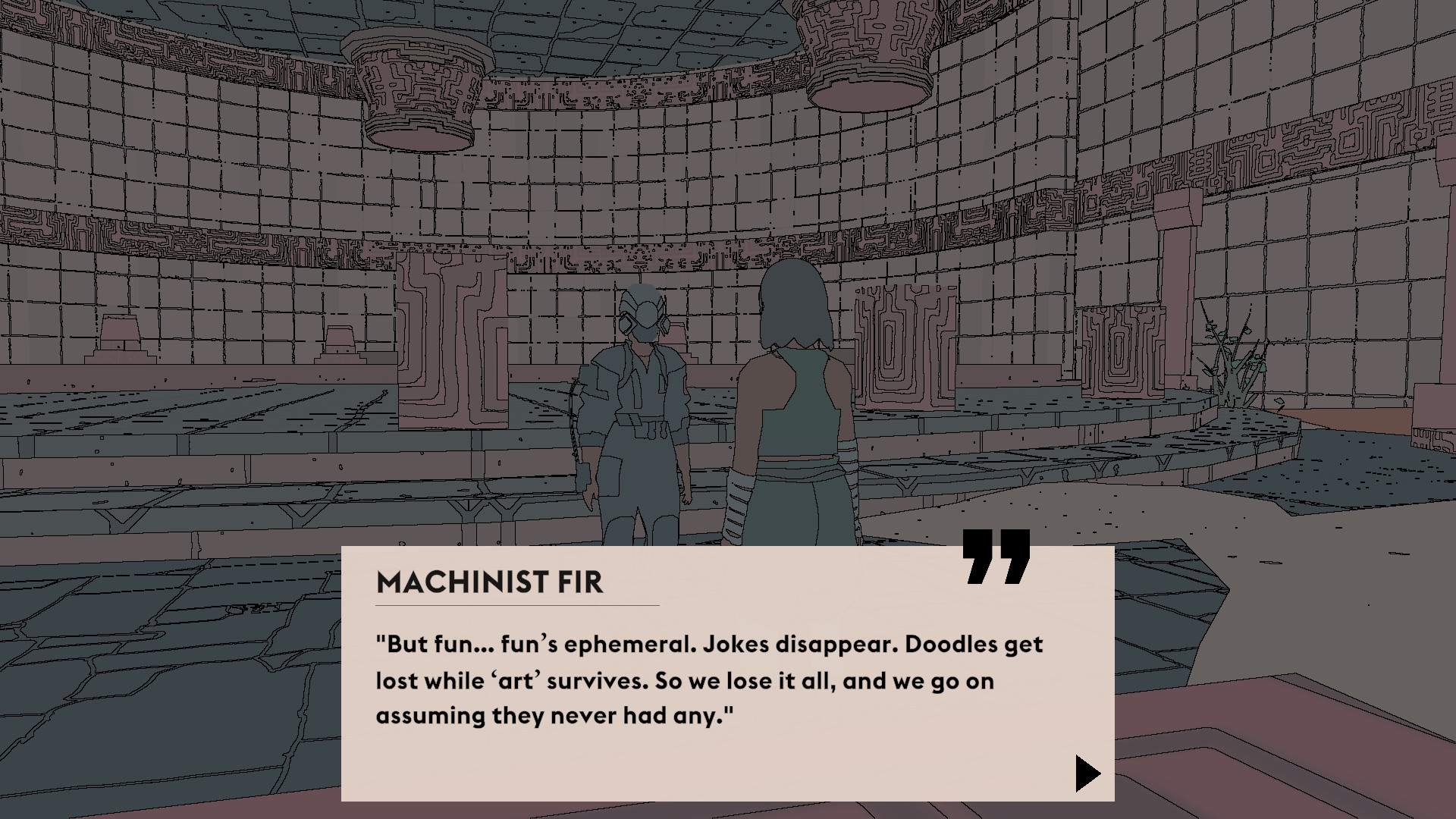
.







